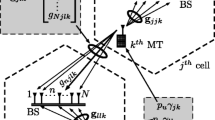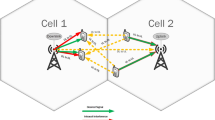Abstract
This paper is concerned with joint beamforming and power control for downlink multi-cell massive multiple-input and multiple-output system. The finite system analysis and large system analysis are successively made for two different system configurations. When base station (BS) antenna number and user number per cell are not large, the finite system analysis of single cell is extended to the multi-cell case after problem reformulation. With the Perron–Frobenius theory and alternative optimization, the dual uplink power and beamformers can be calculated iteratively. Based on the iteration result and the uplink-downlink duality, the final solution is obtained. However, when BS antenna number and user number are large, the large system analysis is employed. In order to reduce computation complexity, the dual uplink power is approximated by its asymptotic equivalent. First, the asymptotic expression of signal to interference plus noise ratio is derived via random matrix theory. Next, the power control problem is reformulated in the asymptotic regime to obtain the asymptotic dual uplink power. As the asymptotic dual uplink power only depends on the second order statistic, it does not require updating along with the channel state information instantaneously. As a result, the computation complexity is drastically reduced.




Similar content being viewed by others
References
Andrews, J. G., Buzzi, S., Wan, C., Hanly, S. V., Lozano, A., Soong, A. C. K., et al. (2014). What will 5G be? IEEE Journal on Selected Areas in Communications,32(6), 1065–1082.
Lu, L., Li, G. Y., Swindlehurst, A. L., Ashikhmin, A., & Zhang, R. (2014). An overview of massive MIMO: Benefits and challenges. IEEE Journal of Selected Topics in Signal Processing,8(5), 742–758.
Lakshminaryana, S., Hoydis, J., Debbah, M., & Assaad, M. (2010). Asymptotic analysis of distributed multi-cell beamforming. In Annual IEEE international symposium on personal, indoor and mobile radio communications, Instanbul, Turkey, 26–30 September 2010 (pp. 2105–2110). https://doi.org/10.1109/pimrc.2010.5671653.
Dahrouj, H., & Yu, W. (2010). Coordinated beamforming for the multicell multi-antenna wireless system. IEEE Transactions on Wireless Communications,9(5), 1748–1759. https://doi.org/10.1109/TWC.2010.05.090936.
Pennanen, H., Tolli, A., & Latva-aho, M. (2011). Decentralized coordinated downlink beamforming via primal decomposition. IEEE Signal Processing Letters,18(11), 647–650. https://doi.org/10.1109/LSP.2011.2168206.
Tolli, A., Pennanen, H., & Komulainen, P. (2011). Decentralized minimum power multi-cell beamforming with limited backhaul signaling. IEEE Transactions on Wireless Communications,10(2), 570–580. https://doi.org/10.1109/TWC.2011.120810.100363.
Lakshminarayana, S., Assaad, M., & Debbah, M. (2015). Coordinated multicell beamforming for massive MIMO: A random matrix approach. IEEE Transactions on Information Theory,61(6), 3387–3412. https://doi.org/10.1109/TIT.2015.2421446.
Asgharimoghaddam, H., Tölli, A., & Rajatheva, N. (2014). Decentralizing the optimal multi-cell beamforming via large system analysis. In IEEE international conference on communications, Sydney, Australia, 10–14 June 2014 (pp. 5125–5130). https://doi.org/10.1109/icc.2014.6884134.
Sanguinetti, L., Björnson, E., Debbah, M., & Moustakas, A. L. (2014). Optimal linear precoding in multi-user MIMO systems: A large system analysis. In IEEE global communications conference, Austin, USA, 8–12 December 2014 (pp. 3922–3927). https://doi.org/10.1109/glocom.2014.7037420.
Schubert, M., & Boche, H. (2004). Solution of the multiuser downlink beamforming problem with individual SINR constraints. IEEE Transactions on Vehicular Technology,53(1), 18–28. https://doi.org/10.1109/TVT.2003.819629.
Huang, Y., Tan, C. W., & Rao, B. D. (2013). Joint beamforming and power control in coordinated multicell: Max–min Duality, effective network and large system transition. IEEE Transactions on Wireless Communications,12(6), 2730–2742. https://doi.org/10.1109/TWC.2013.042313.120752.
Seneta, E. (1981). Non-negative matrices and markov chains. New York: Springer.
Cai, D. W. H., Quek, T. Q. S., Tan, C. W., & Low, S. H. (2012). Max–min SINR coordinated multipoint downlink transmission—duality and algorithms. IEEE Transactions on Signal Processing,60(10), 5384–5395. https://doi.org/10.1109/TSP.2012.2208631.
Schubert, M., & Boche, H. (2002). A unifying theory for uplink and downlink multiuser beamforming. In International Zurich seminar on broadband communications access: Transmission—networking, Zurich, Switzerland, 2002 (pp. 27-21–27-26). https://doi.org/10.1109/izsbc.2002.991770.
Tse, D. N. C., & Hanly, S. V. (1999). Linear multiuser receivers: Effective interference, effective bandwidth and user capacity. IEEE Transactions on Information Theory,45(2), 641–657. https://doi.org/10.1109/18.749008.
Assche, W. V. (1987). Asymptotics for orthogonal polynomials. Heidelberg: Springer.
Yates, R. D. (1995). A framework for uplink power control in cellular radio systems. IEEE Journal on Selected Areas in Communications,13(7), 1341–1347. https://doi.org/10.1109/49.414651.
Krause, U. (2001). Concave Perron–Frobenius theory and applications. Nonlinear Analysis,47(3), 1457–1466.
Blondel, V. D., Ninove, L., & Dooren, P. V. (2005). An affine eigenvalue problem on the nonnegative orthant. Linear Algebra and Its Applications,404(2), 69–84.
Acknowledgements
This work is supported by “Beijing Key Laboratory of Work Safety Intelligent Monitoring (Beijing University of Posts and Telecommunications)”.
Author information
Authors and Affiliations
Corresponding author
Ethics declarations
Conflict of interest
The authors declare that they have no conflict of interest.
Additional information
Publisher's Note
Springer Nature remains neutral with regard to jurisdictional claims in published maps and institutional affiliations.
Rights and permissions
About this article
Cite this article
Zu, Y., Shao, L. & Hou, B. Joint Beamforming and Power Control for Downlink Multi-cell Massive MIMO System. Wireless Pers Commun 111, 245–266 (2020). https://doi.org/10.1007/s11277-019-06855-4
Published:
Issue Date:
DOI: https://doi.org/10.1007/s11277-019-06855-4




